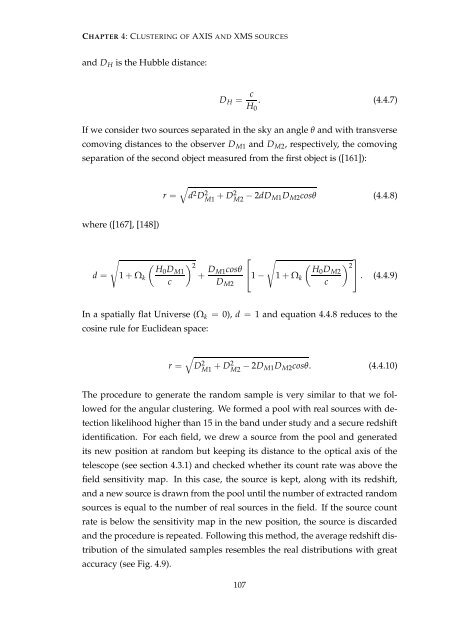pdf - SRON
pdf - SRON
pdf - SRON
You also want an ePaper? Increase the reach of your titles
YUMPU automatically turns print PDFs into web optimized ePapers that Google loves.
CHAPTER 4: CLUSTERING OF AXIS AND XMS SOURCES<br />
and D H is the Hubble distance:<br />
D H = c H 0<br />
. (4.4.7)<br />
If we consider two sources separated in the sky an angle θ and with transverse<br />
comoving distances to the observer D M1 and D M2 , respectively, the comoving<br />
separation of the second object measured from the first object is ([161]):<br />
r =<br />
√<br />
d 2 D 2 M1 + D2 M2 − 2dD M1D M2 cosθ (4.4.8)<br />
where ([167], [148])<br />
d =<br />
√<br />
1 + Ω k<br />
(<br />
H0 D M1<br />
c<br />
⎡ √<br />
) 2<br />
+ D M1cosθ<br />
⎣1 −<br />
D M2<br />
1 + Ω k<br />
(<br />
H0 D M2<br />
c<br />
) 2<br />
⎤<br />
⎦ . (4.4.9)<br />
In a spatially flat Universe (Ω k = 0), d = 1 and equation 4.4.8 reduces to the<br />
cosine rule for Euclidean space:<br />
r =<br />
√<br />
D 2 M1 + D2 M2 − 2D M1D M2 cosθ. (4.4.10)<br />
The procedure to generate the random sample is very similar to that we followed<br />
for the angular clustering. We formed a pool with real sources with detection<br />
likelihood higher than 15 in the band under study and a secure redshift<br />
identification. For each field, we drew a source from the pool and generated<br />
its new position at random but keeping its distance to the optical axis of the<br />
telescope (see section 4.3.1) and checked whether its count rate was above the<br />
field sensitivity map. In this case, the source is kept, along with its redshift,<br />
and a new source is drawn from the pool until the number of extracted random<br />
sources is equal to the number of real sources in the field. If the source count<br />
rate is below the sensitivity map in the new position, the source is discarded<br />
and the procedure is repeated. Following this method, the average redshift distribution<br />
of the simulated samples resembles the real distributions with great<br />
accuracy (see Fig. 4.9).<br />
107
















